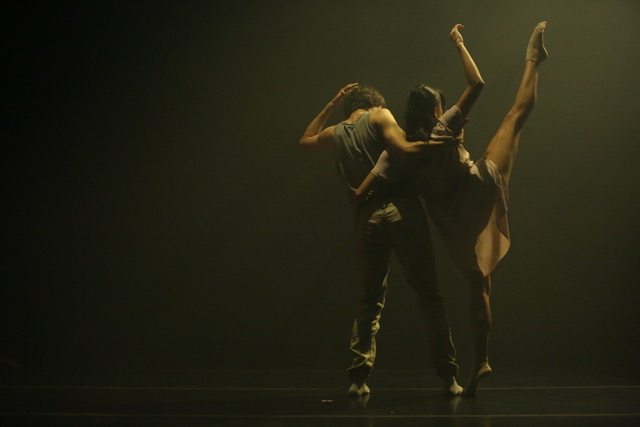Ishida Dance Company Makes a Promising Debut in Houston with you could release me
 After two thwarted-by-COVID attempts in two years, Austin-based Ishida Dance Company finally made its Houston debut this weekend at Midtown Arts and Theater Center Houston (MATCH), bringing a quartet of dance premieres to the intimate venue with their program, you could release me.
After two thwarted-by-COVID attempts in two years, Austin-based Ishida Dance Company finally made its Houston debut this weekend at Midtown Arts and Theater Center Houston (MATCH), bringing a quartet of dance premieres to the intimate venue with their program, you could release me.
Ishida Dance, launched in 2019 by California native Brett Ishida, is a pick-up company comprised of highly pedigreed freelance dancers from all over the country, including two Houston High School for the Performing and Visual Arts (and Julliard School) alumni, Maddie Medina and Zack Tang. Every one of the seven performers on Friday night appeared in top form and possessed skillful command of their instruments. These are dancers who can extend one pointed leg high into the air as they spiral head-first to the floor, sweep all of their weight effortlessly into their hands and be up again in a beautifully-aligned arabesque without a bit of ostentation. Their virtuosity, from the up-close vantage Box 2 at MATCH provides, was truly a treat
In contrast to most classical or theatrical dance which is driven by linear plot points, Ishida’s stories and the stories crafted by her selected guest choreographers emerge abstractly through emotional milestones. The soft-spoken Ishida, who is classically trained in ballet and has a background in ancient Greek literature, poetry and philosophy, introduced each of the four narrative-driven works on the program. While helpful in viewing the piece to come and providing some visual margin in a brief (under 75-minute) but movement-packed evening of dance, I would have preferred continuity in programming over these small interjections, allowing the works, with a few program notes, to speak first for themselves. A Q&A with the choreographers and dancers after the performance might have felt less stilted and given the dancemakers welcome time to share insight or curious audience members the opportunity to investigate the dance-making process and build familiarity with the fledgling company.
Through Ishida’s introductions we learned that Finnish-British choreographer and filmmaker Kristian Lever’s duet An Intimate Distance, premiering for the first time in the U.S., was originally created on Hamburg Ballet for a man and a woman. Exploring the angst of a deteriorating relationship, it was performed in this instance by two men at Ishida’s suggestion. How this might compare to the original, which earned Lever the prize for choreography in the international Erik Bruhn competition, is hard to say. However, the choice seemed a natural one given the intense athleticism of the choreography.
An Intimate Distance also served as an intriguing follow-up to the show’s opening excerpt of 10,000 years I love you. Choreographed by Ishida, 10,000 years presents as a free-flowing series of duets performed by a trio of dancers depicting (in Ishida’s own words) “different ways of loving.” Supported by a mid-20th century Latin American soundtrack, the work culminates with The Turtles classic Happy Together. This collection of musical accompaniment is the prominent tie to what Ishida cites as her source of inspiration: Happy Together, a film festival triumph regarded as one of the best LGBT films of the late-90s New Queer Cinema movement. Ishida’s work is lighthearted, unexpectedly making it seem like the melancholy film is somehow related or even a catalyst also for Lever’s raw portrait of relationship that follows it.
There is an emerging trend in contemporary dance to stuff choreography with a continuous serpentine flow of motion. While spectacular, it can begin to feel monotonous to the viewer who sits outside what seems like a stream of consciousness, looking for an elusive interval to connect or reflect. This is a grievance I cannot dump solely on Ishida Dance but I would be remiss to not mention that I found it illustrated in the deluge of movement throughout you could release me.
Guest choreographer Emilie Leriche, who appears later in the program as a dancer, presented a new work Fletcher with the note that she and the dancers spent time exploring beginnings and endings during their creation period of just two weeks. There were welcome moments of intentional pause and interruption embedded in the overall movement cadence. Dancers Katie Lake and Jackson Haywood engaged in interaction that folded and unfolded around a wooden stool like the mysterious slips of paper that repeatedly drew their focus from one another.
The program’s final installment changeling, choreographed by Ishida, was another trio and provided some of the evening’s most captivating staging and partnering between the earlier-mentioned Medina and Tang. Leriche performs what could perhaps be the ego or a facet of the self or personality of one woman (Medina) that gradually and reluctantly disengages as she falls, what I’d guess is again, into the arms of a man (Tang).
Having come from well outside the region with connections throughout the dance world, Brett Ishida’s identification of Austin (and Houston) as fertile soil for her artistic pursuits is something worth noting. Ishida Dance Company has emerged in these dual cities at a difficult time for the arts. Still, this debut held a great deal of promise and I look forward to what Ishida can accomplish given the support and time to develop the company’s nucleus, gain momentum in each community, and deepen the cohesive connections between dancers and choreographers through regular and consistent engagement.



Recent Comments